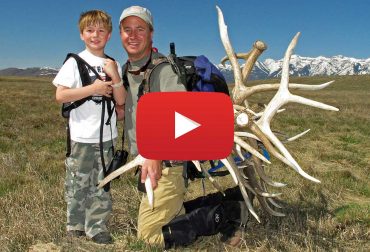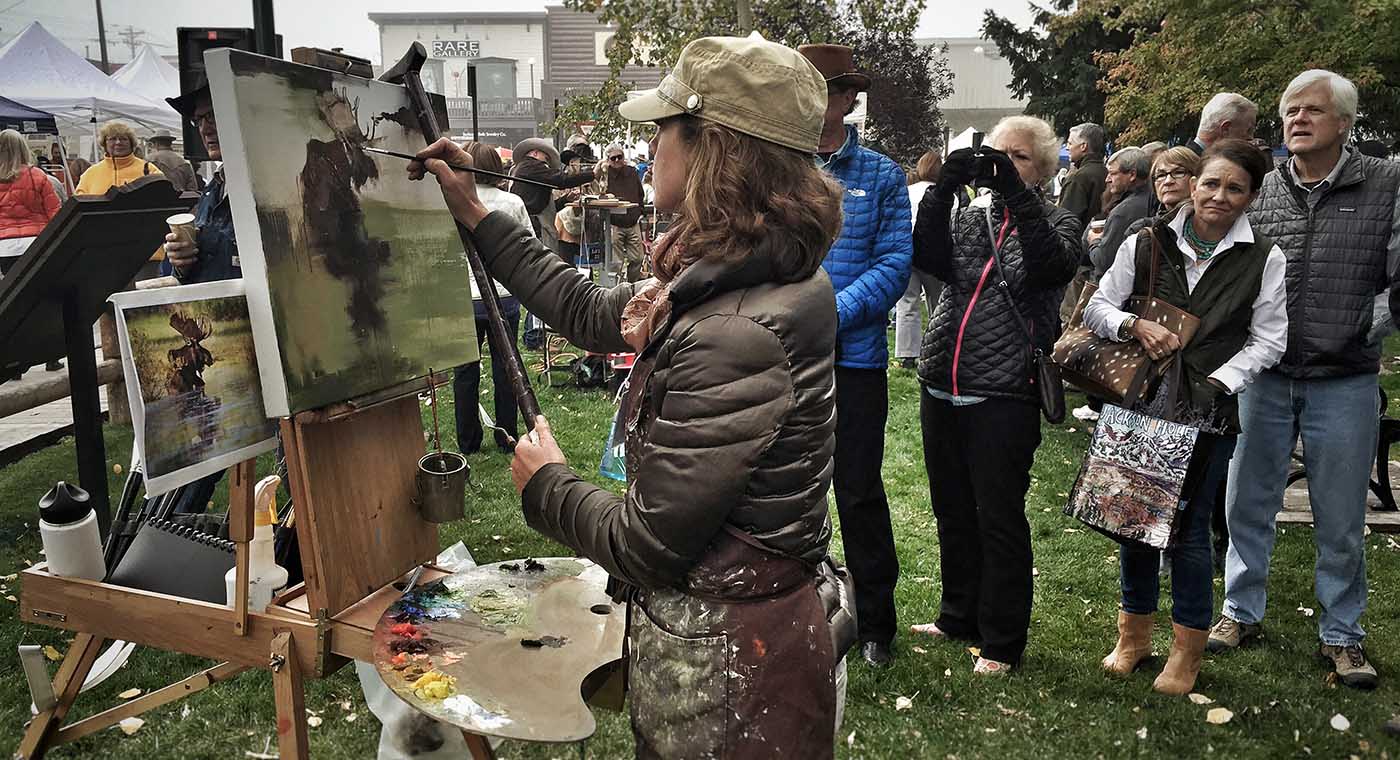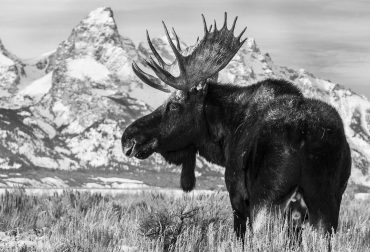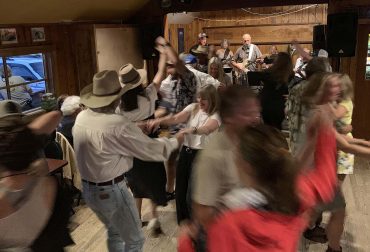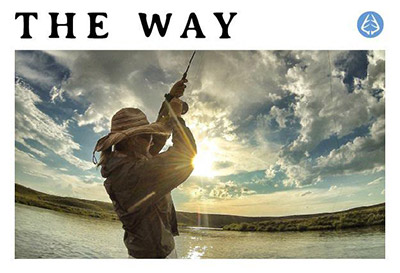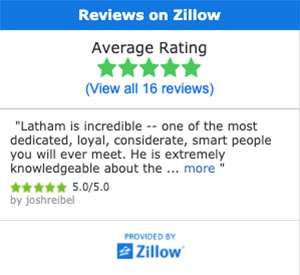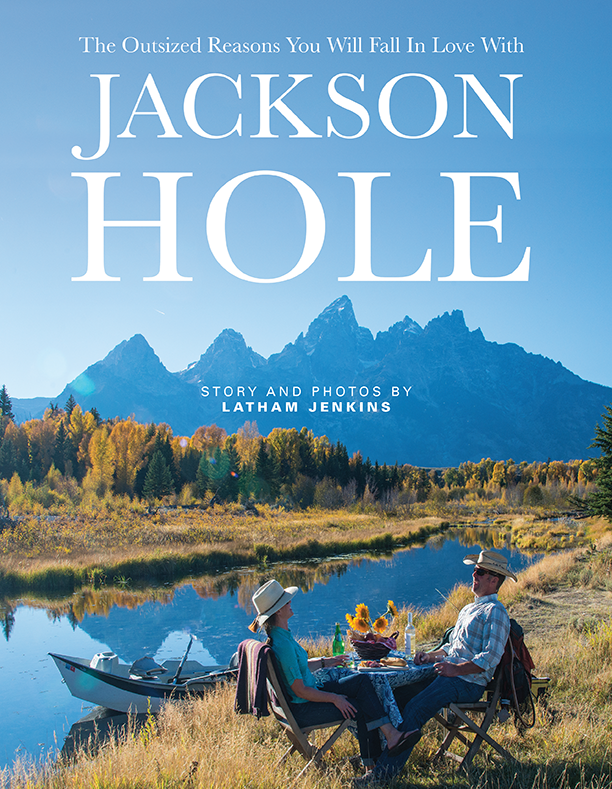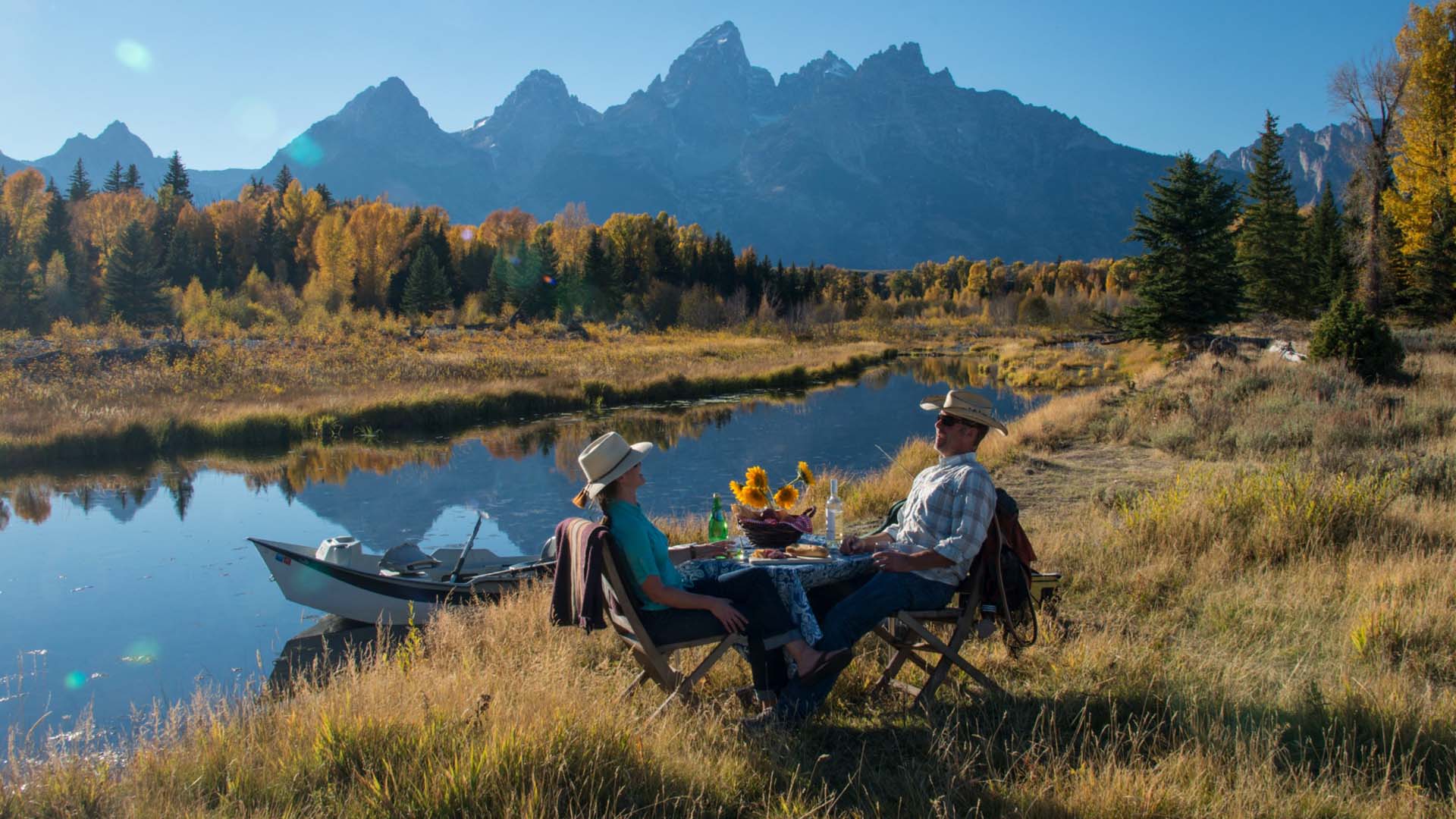
Outsized Lifestyle in Jackson Hole
Every morning, I wake up with a childlike curiosity about what might lie outside my window. Has the bull moose that sparred with the lacrosse net returned?
Will I see the elk that kept me up all night bugling? Maybe I’ll encounter his romantic conquest or one of his rivals. Living in the middle of a wildlife migration corridor in Jackson Hole, I happen upon animals like this almost daily. But I still marvel at every sighting—I even wake up my children to share wildlife sightings with them.
Order a free printed copy of “The Outsized Reasons Why You Will Fall in Love with Jackson Hole.“
Coexisting with such iconic wildlife is one of the reasons why I cherish living in this special place. Jaw-dropping scenery is another. As the morning alpenglow paints the sky pink behind the Teton Mountain Range, I drive my kids 4 miles through an astounding landscape to the classic red schoolhouse in Wilson, keeping a tally of the wildlife we see on the way. We spot elk, coyotes and fox in the open meadows, and bald eagles and osprey nests on the tops of power poles. We crane our necks to look for moose in the willow bottoms.
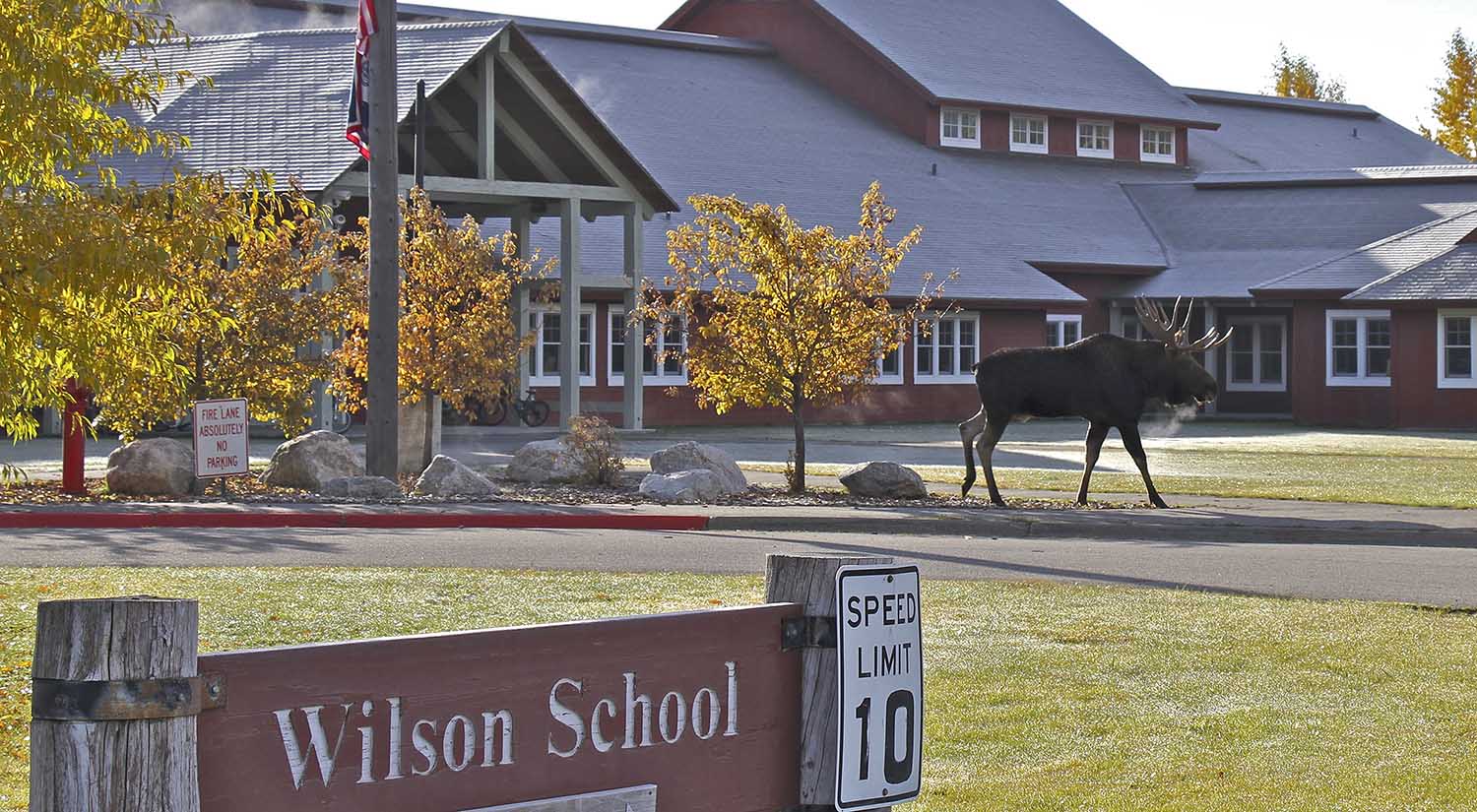
Bull moose visiting Wilson Elementary School. Photo: Renee Glick
Yet another reason for my love of Jackson Hole is its powerful sense of community. The scene at my children’s school reminds me of a Norman Rockwell painting. Young families walk together, bike or pull their kids in a sled to school, with the non-school-aged children in tow. Some days we are greeted by moose that frequent the schoolyard.
I often cross paths with these same parents during the course of our work days, for example, when I stop for coffee at Pearl Street Bagels in Wilson. Later in the day, I may connect with them again on the sidelines of a sports field or at an evening event. No one can live truly anonymously in this tightly knit community. As a consequence, we hold each other accountable, offering our best selves to the world day in and day out. It’s as if the frontier days never ended—we just have a few more creature comforts than our Wild West predecessors had.
The magical quality of this idyllic setting seeps into every aspect of our daily lives, from our communal devotion to land stewardship to our passion for outdoor recreation and celebration of art, culture and community—all at the same outsized scale as our natural surroundings.
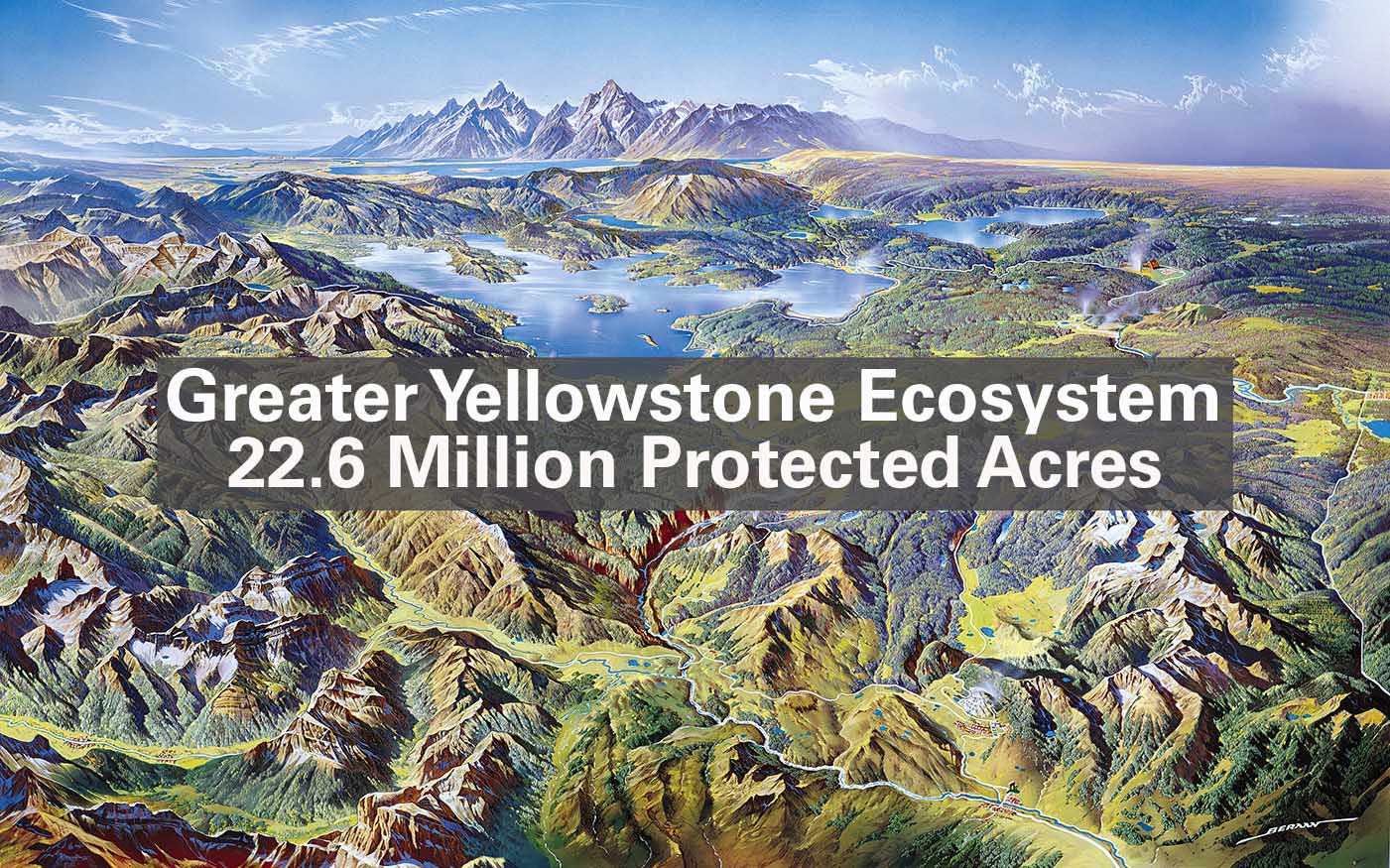
Largest protected area in the lower 48 states, Greater Yellowstone Ecosystem.
Outsized Landscape
Jackson Hole’s most obvious advantage is its unmatched grandeur of landscape—wide-open meadows, trout-filled rivers, boundless forests and the unforgettable spires of the Teton Mountain Range. The wonderment that the Native Americans and early pioneers felt when they first saw the vast spaces surrounding the Tetons still exists today, thanks to the wonderland that is the Greater Yellowstone Ecosystem. The GYE, as we call it, has a 22.6 million-acre assemblage of contiguous, protected land, including Yellowstone and Grand Teton national parks and other adjacent wild lands across Montana, Wyoming and Idaho. It’s the largest and wildest such region in the lower 48 states.
“If an ecosystem begins anywhere, this would be it,” says Yale ecologist Arthur Middleton in the May 2016 issue of National Geographic (the first issue the magazine ever dedicated to one subject), which describes the GYE as an ecological island and “an intricate, interactive compoundment of living creatures, relationships, physical factors, geological circumstances, historical accidents and biological circumstances.”
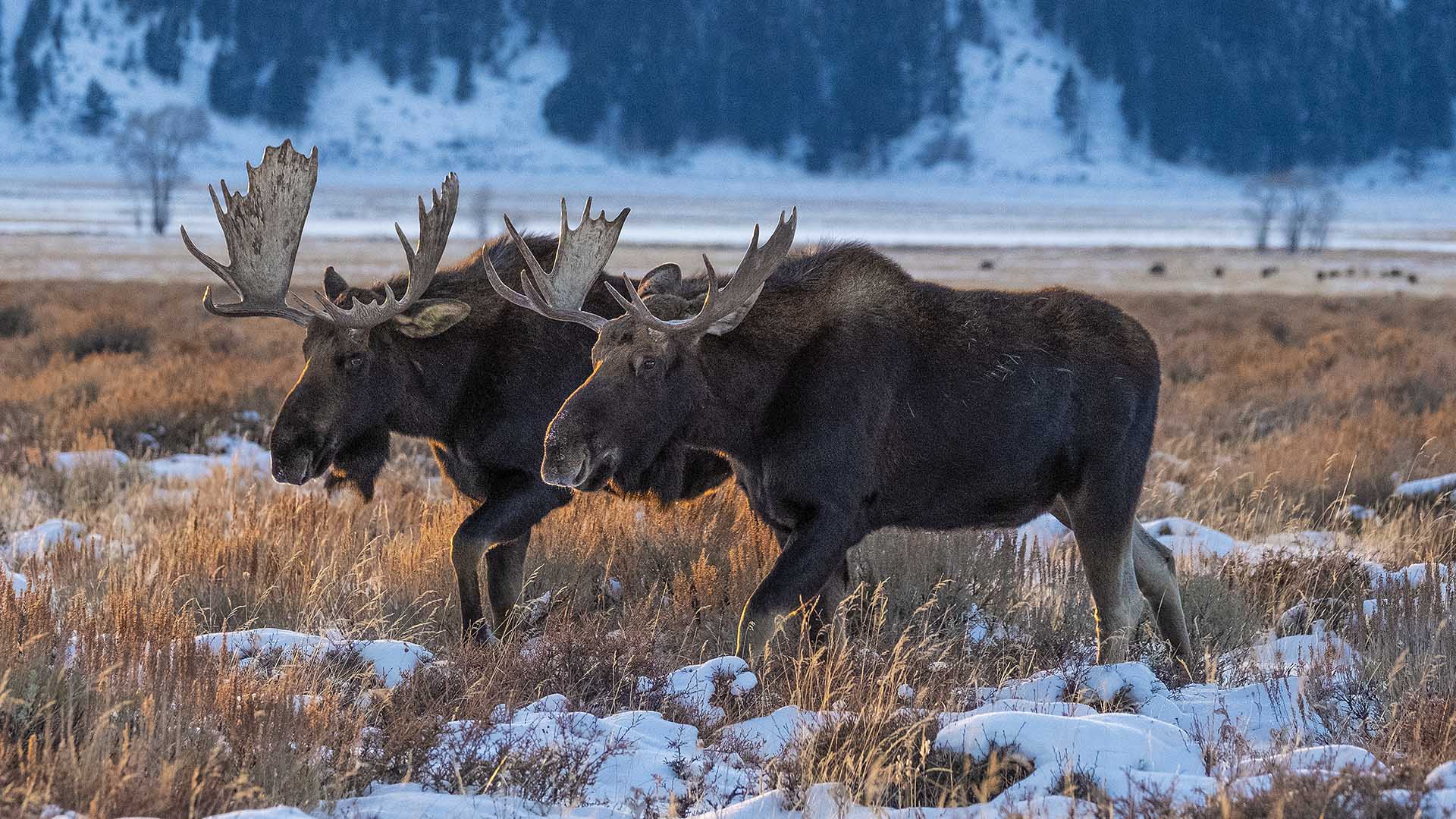
Bull moose feeding on bitterbrush, with bison in the distance, Grand Teton National Park
An integral part of the GYE, Jackson Hole is often called the American Serengeti. The scale of its open spaces, like the length of a moose’s legs, is outsized. So is the number of species that call this place home. We share this ecosystem with 300 species of birds, 16 species of fish, five species of amphibians, six species of reptiles, and 67 species of mammals—including seven native ungulate species and two bear species. This is one of the few places on earth that provides enough habitat for so much wildlife to survive and thrive.
Since 1975, when grizzly bears were placed on the endangered species list, the number of grizzlies has more than tripled to over 700, thanks to the diverse food supply and unhindered land. Jackson Hole also hosts the largest elk herd in the world and a thriving community of native bison (the symbol of the state flag), as well as bighorn sheep and numerous raptors. We have even played a major role in the revival of the bald eagle, our national bird.
I always keep a camera in my car to capture not only chance encounters with wild animals but also the changing face of the valley itself, from spring rainbows and summer sunsets to bull moose walking through town and the ever-changing elk herd that winters on the National Elk Refuge. Witnessing this unique coexistence between mankind and nature is exhilarating on a daily basis.
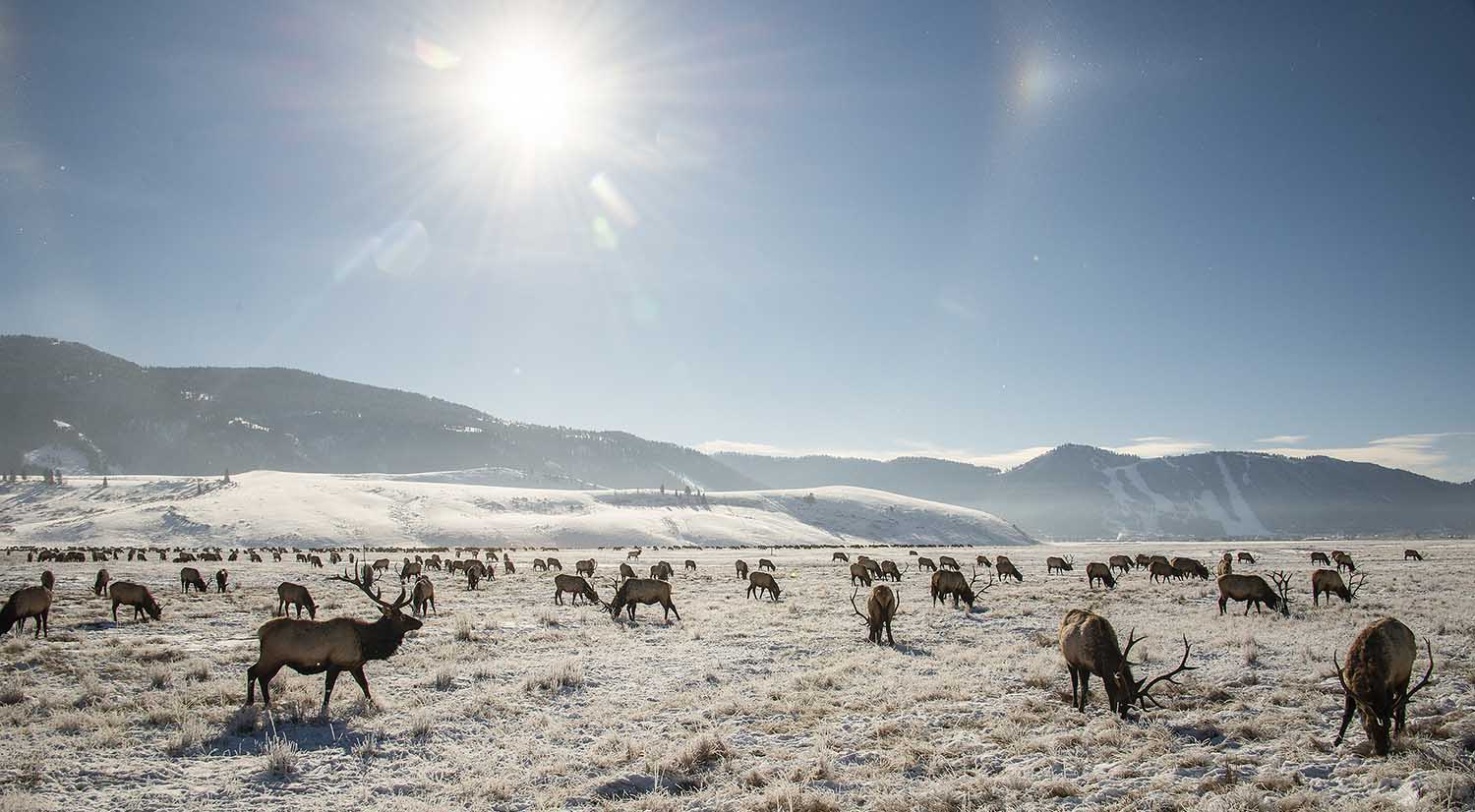
Jackson Hole’s National Elk Refuge.
Jackson Hole Elk Herd
Being home to one of the largest elk herds on earth makes Jackson Hole a special place. Elk figure prominently in our culture. The original settlers relied on them for sustenance and, while there are a lot of other ways to find food today, the fall harvest remains a ritual for locals, whether they are hunting on horseback or on foot.
An average of 7,500 migrating elk winter on 24,700 acres in the National Elk Refuge, an area just north of the town of Jackson that is surrounded almost entirely by national forest and national park.
In the spring, after the elk have shed their antlers and begun to seek higher ground, the Elk Refuge opens its borders to the Boy Scouts of America first, then to antler hunters. The Boy Scouts, who have been getting the pick of the litter since 1950, sell their antlers at the annual Elkfest auction on the Town Square, another incredible scene.
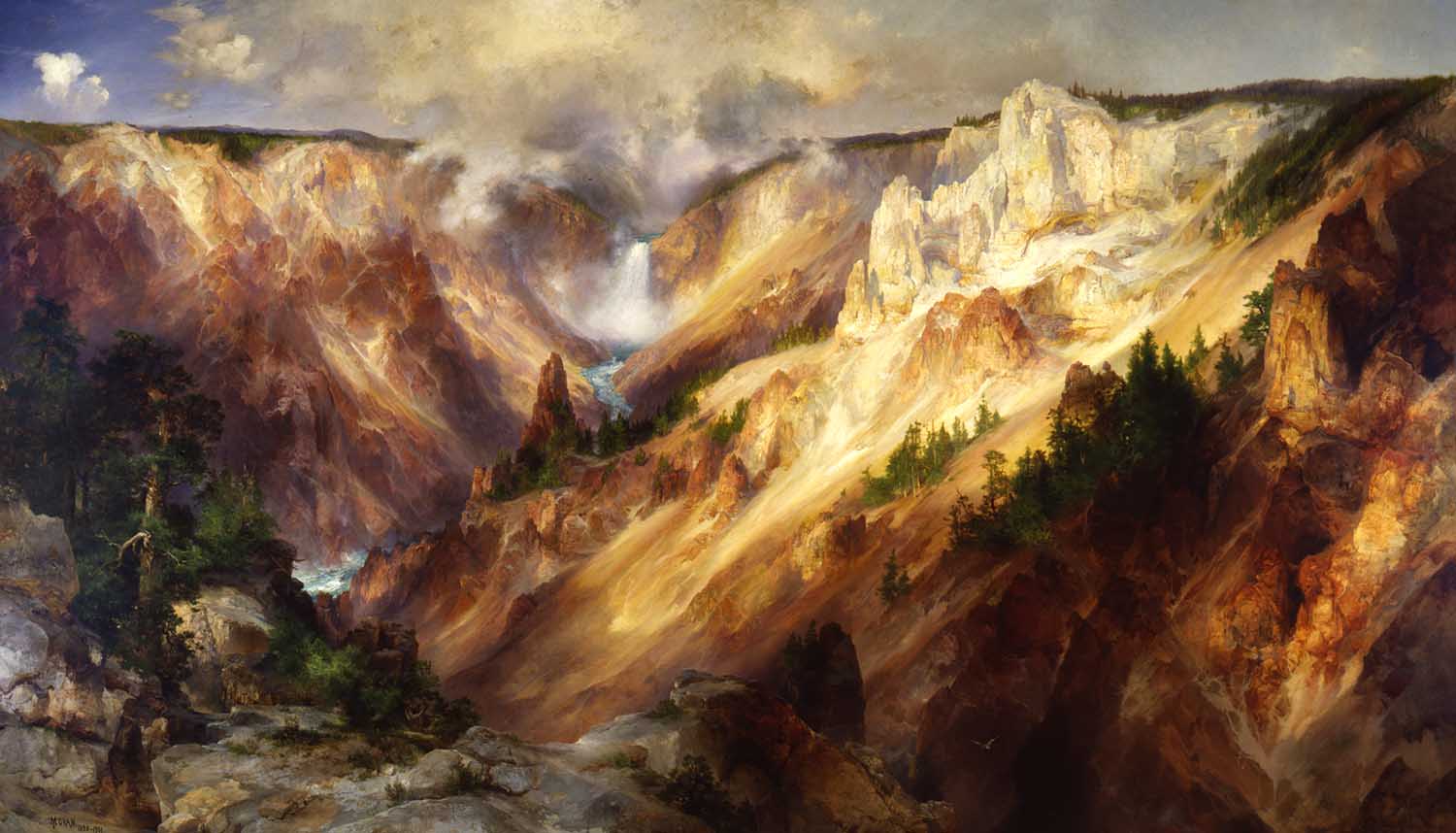
“The Grand Canyon of the Yellowstone,” by Thomas Moran, whose paintings were used to persuade Congress to designate Yellowstone as a national park.
Outsized Philanthropy & Land Protection
While it was the natural beauty that first attracted me to Jackson Hole, it is the community of people this place draws, people who share a passion for wildlife and wildlands, that keeps me here. The list of go-getters with a commitment to give back and a determination to keep Jackson Hole wild is vast, as well, and many generations long.
Recognizing the magic of this region, early conservationists quickly established its place in history. Explorers in what is now Yellowstone National Park were awestruck by this land of fire, ice and wild animals; they insisted that it be preserved.
On March 1, 1872, Congress established Yellowstone National Park in the territories of Montana and Wyoming “as a public park or pleasuring-ground for the benefit and enjoyment of the people.”
Its southern neighbor, Grand Teton National Park, was established 57 years later.
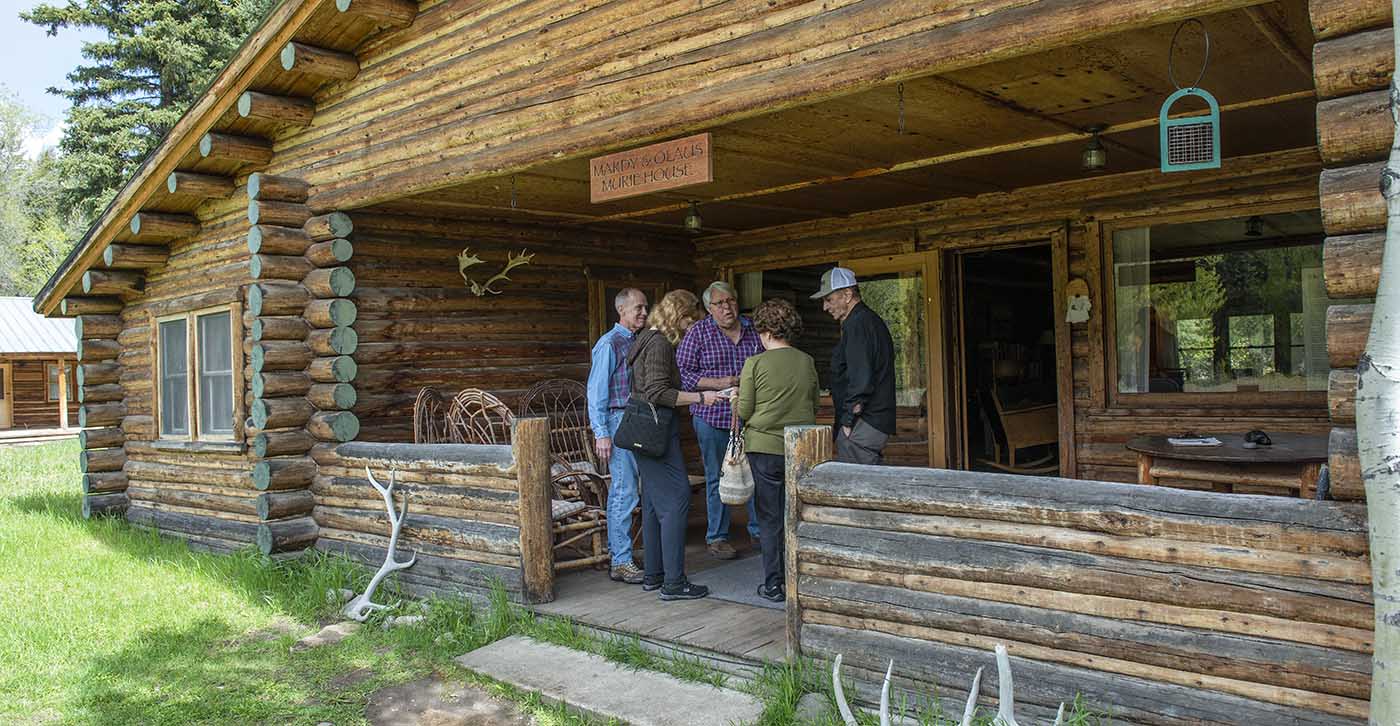
The Murie House, now on the National Register of Historic Places, was the site of discussions that led to the creation of the Wilderness Act in 1964 and the modern conservation movement.
Grand Teton National Park is also home to the Murie Ranch, which is known as the birthplace of conservation because of the pioneers it attracted and the legislation that originated there. In the 1940s, Olaus Murie, a conservationist who had come to Jackson Hole to study the elk herd, settled on the south fork of the Snake River near the community of Moose. Together, he and his brother Adolph Murie, a scientist, and their respective wives, author Mardy Murie and Louise Murie (later MacLeod)—both also dedicated conservationists—began some of the earliest conversations about protecting wildlands on their historic front porch. The Muries sparked a national movement that led to the creation of both the 1964 Wilderness Act and the Arctic National Wildlife Refuge. Their cabin, a national landmark that now belongs to the National Park Service, was the headquarters for The Wilderness Society in the 1950s when Olaus served as its president. A plaque next to rocking chairs on the front porch marks the spot where the modern conservationist movement was born.
John D. Rockefeller Jr., the son of the Standard Oil founder, was another Jackson Hole visionary and a generous steward of this land. In the 1920s, he purchased 35,000 acres to enlarge Grand Teton National Park. The Rockefellers retained 3,000 acres for their ranch, which they later donated as well.
The Rockefeller family inspired a long line of philanthropists who also felt compelled to protect the land around Grand Teton National Park. To date, the Grand Teton National Park Foundation has funded more than $75 million in projects, including the Craig Thomas Discovery and Visitor Center, the restoration of trails around Jenny Lake (the most visited spot in the park) and the purchase of Antelope Flats from the state of Wyoming.
Now home to more than 200 nonprofit organizations, Jackson Hole is the largest philanthropic community in the country in terms of gifts per capita, thanks to the generous philanthropists who have come to live here.
In 1997, an anonymous couple, referred to as “Old Bill,” donated $500,000 to create a community-driven, collaborative fundraiser run by the Community Foundation of Jackson Hole. With matching local gifts, Old Bill’s Fun Run has raised $173 million for local nonprofits.
Like Old Bill, many of the philanthropists who are attracted to Jackson Hole appreciate the privacy provided by the valley’s great open spaces. They like to live simply and do not draw attention to themselves. For example, Yvon Chouinard, the founder of Patagonia, preaches mindful consumption and keeps a bare-bones log cabin that he and friends built in 1976 not far from Grand Teton National Park.
Today, thanks to a century-old legacy of conservation and philanthropy, an outsized proportion of open space remains undeveloped in Jackson Hole. Private land is scarce here because more than 97 percent of the land in Teton County (the county in which Jackson Hole lies) is federally owned or managed by the state. Of the 3 percent remaining in private ownership, amounting to about 77,000 acres, the Jackson Hole Land Trust alone protects almost 25,000 acres. Additional protections limit development in critical wildlife habitat like the river bottoms. This leaves only about 2 percent of the land available for human development.
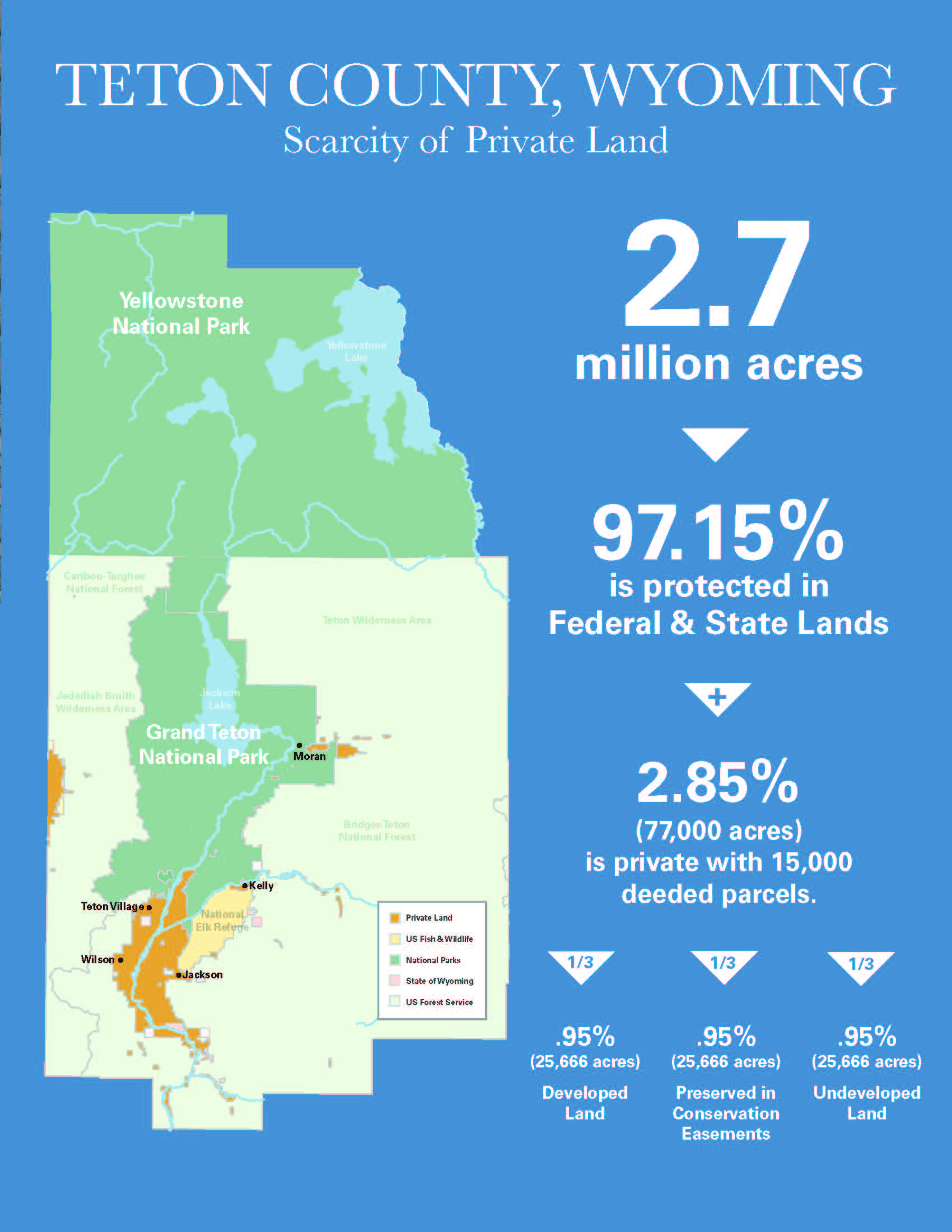
Grand Teton and Yellowstone national parks make up a large portion of the federally protected land in Jackson Hole. Around 40 percent of Yellowstone’s 2.2 million acres and all of Grand Teton National Park’s 310,000 acres are in the county. Grand Teton National Park also offers 200 miles of hiking trails.
In addition to the national parks, Jackson Hole includes state lands, portions of three national forests, one national wildlife refuge, Bureau of Land Management holdings and private and tribal lands. The Bridger Teton National Forest alone has more than 2,000 miles of hiking trails.
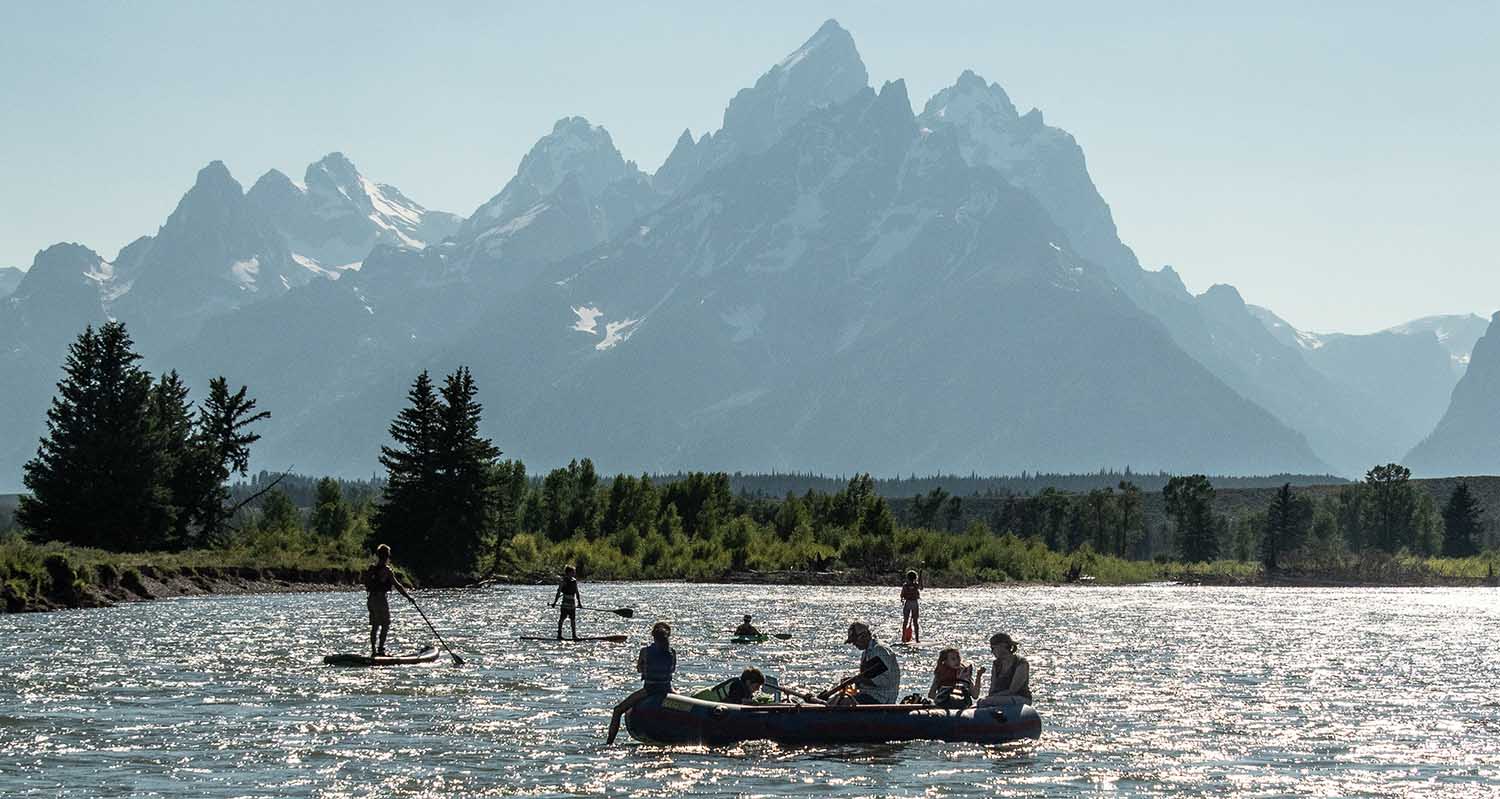
Family time on the Snake River, Grand Teton National Park.
Outsized Recreational Opportunities
All of this open space makes Jackson Hole a world-class playground, featuring one of the greatest ranges of mountain activities on the planet—everything from climbing to fishing. Whether you are driving around looking for grizzlies to come out of hibernation, hiking to Phelps Lake for a swim or boating and camping on Elk Island in the middle of Jackson Lake, there are a phenomenal variety of activities to explore.
Having fun is a way of life in Jackson Hole. We structure our days around outings with friends, be they early morning boot-packs up Mount Glory to ski down before work or hikes with dogs up the old Teton Pass road. Weekend adventures take you farther afield, with camping on the lakes, backpacking in the Tetons, and rafting and fishing on the rivers.
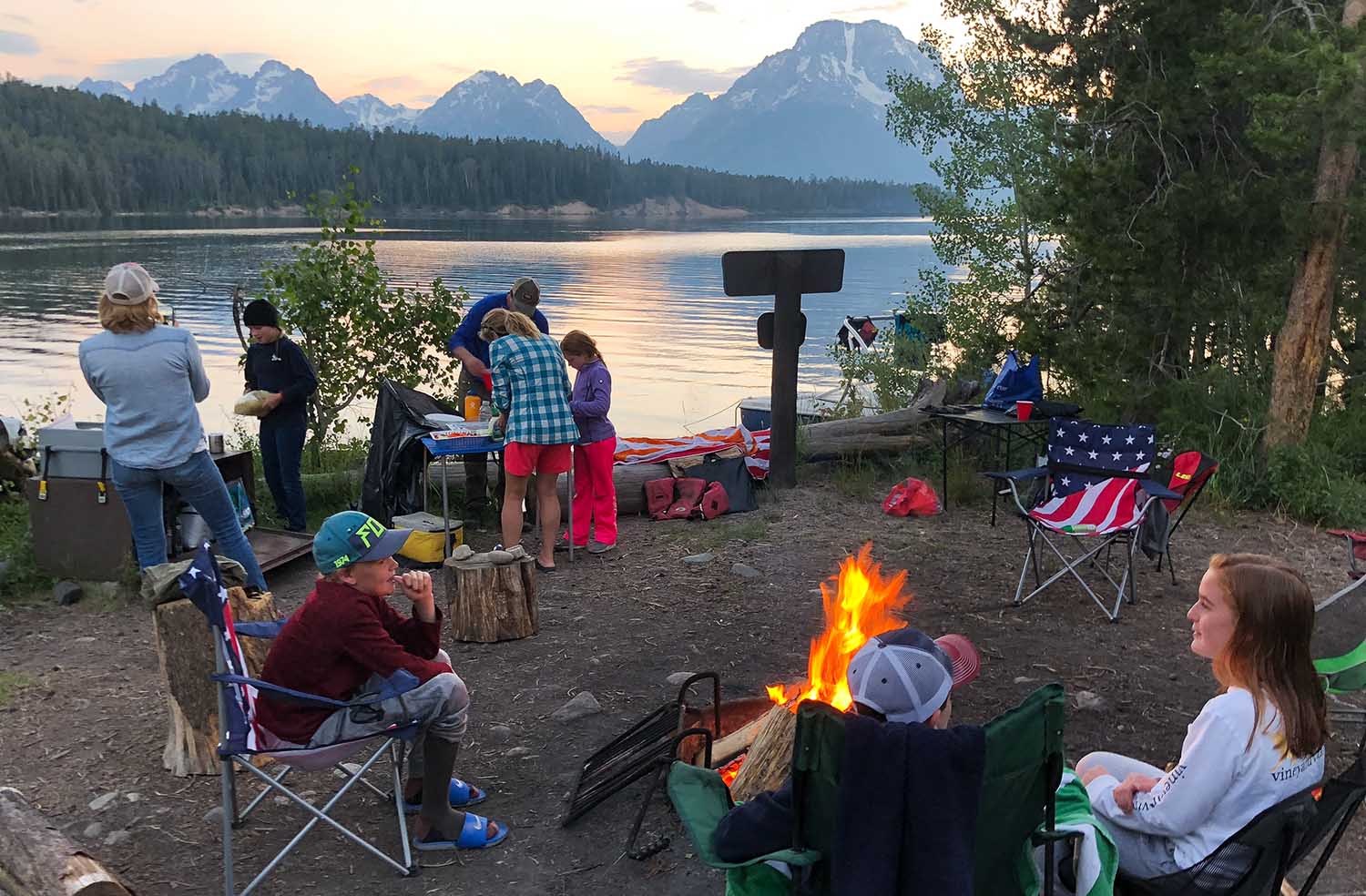
Camping on Jackson Lake, Grand Teton National Park.
One thing I’ve learned after living here for almost 30 years is that the amount of recreational gear in my mudroom never ceases to grow. In fact, the best way to get to know Jackson Hole residents is by looking at the overflow of gear in their garages. My outsized garage houses paddleboards, kayaks, inner tubes, bikes, golf clubs, and camping, fishing and hunting gear, not to mention our quiver of skis. Over the years I have come to realize that no other place on earth offers as many recreational opportunities as Jackson Hole does.
While other ski destinations in the West are seeing increasingly shorter winters with declining snowfall, Jackson Hole has been a safe bet for winter sports. Since 2014, we have had the three snowiest Februaries on record, according to local meteorologist Jim Woodmencey, author of the website MountainWeather.com. More and more snow enthusiasts are flocking to the Tetons, one of the few Rocky Mountain regions that has consistently received more than 300 inches of snow per year.
Jackson Hole Mountain Resort
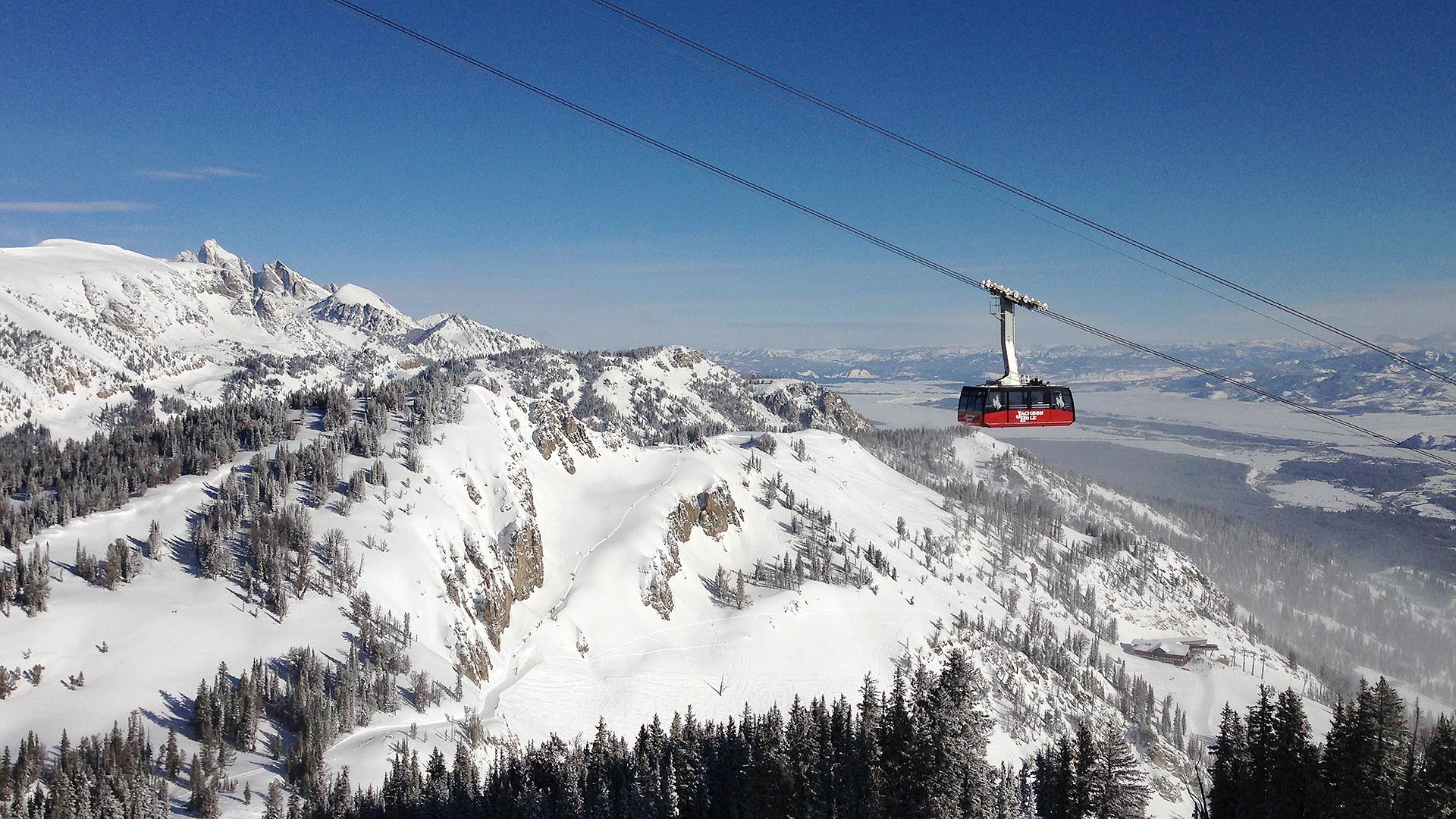
Jackson Hole’s iconic Tram, “Big Red,” rising 4,139 vertical feet to the “Top of the World” summit.
To many experts, Jackson Hole Mountain Resort, or JHMR, is the holy grail of skiing, thanks to the visionaries who built it and have maintained the integrity of its 4,000-plus-foot vertical drop. Voted best ski resort by Forbes Magazine in 2016, 2017 and 2018, it is one of the last remaining privately owned ski resorts in America, allowing the owners to provide outsized amenities compared to corporately owned resorts. Since 1992, when the Kemmerer family bought the resort with money they made selling one of the largest coal mines in the U.S., they have invested more than $200 million in capital improvements, including a new tram and two gondolas, thus upholding JHMR’s reputation for having some of the steepest and deepest terrain in North America.
In recent years, the resort has become a much bigger summer destination for those who want to get up high. It hosts yoga on the deck at the top of the gondola, chairlift rides to mountain bike trails, tandem paragliding, bungee-jumping trampolines, a ropes course and a free summer concert series. The tram is open almost all year-round for those who like to hike as well as ski. JHMR is also home to the Grand Teton Music Festival, which features world-class chamber music.
Snow King Mountain Resort
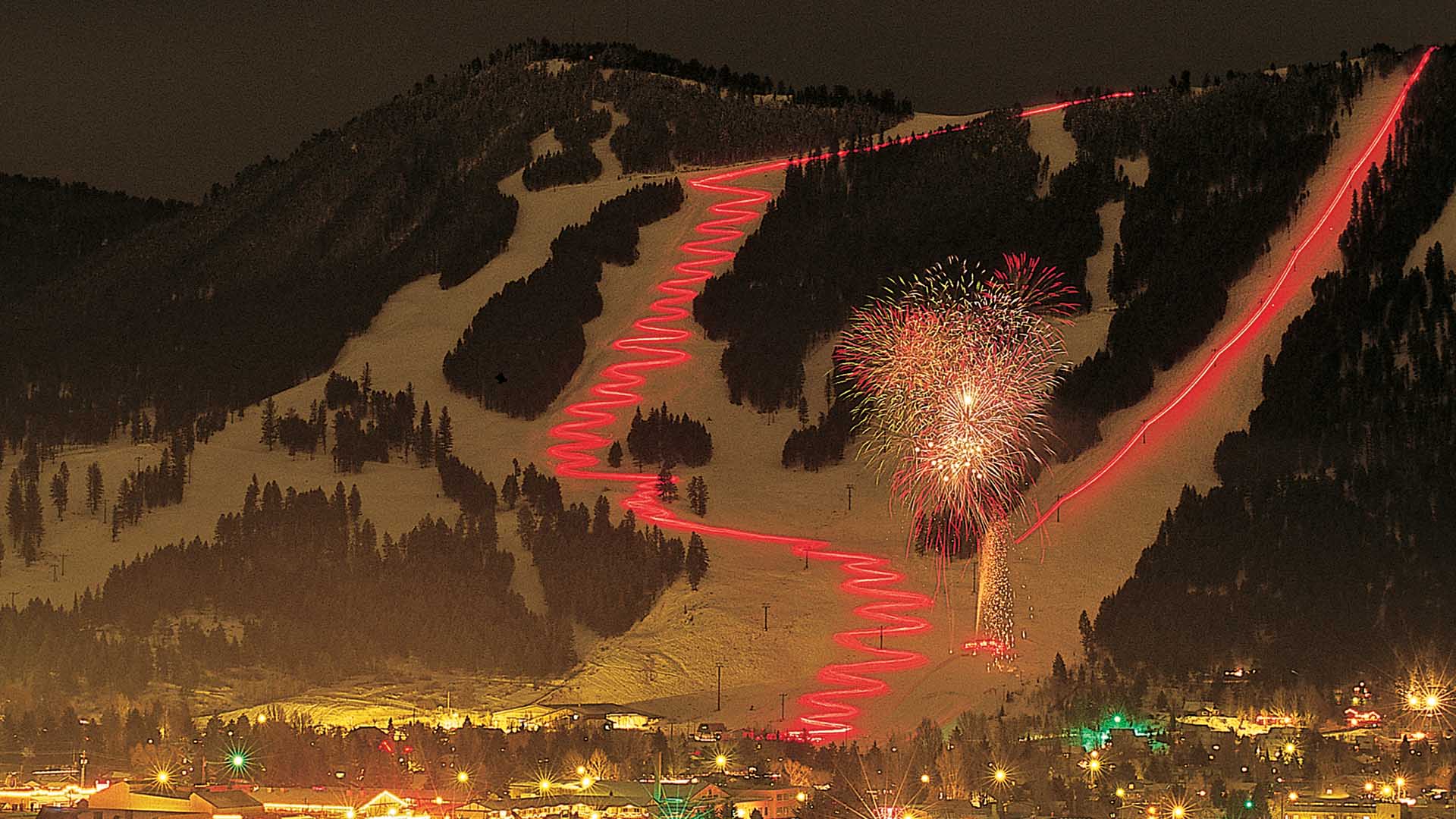
“The King” is Jackson Hole’s original and Wyoming’s first ski hill, established in 1936.
Snow King Mountain Resort, Jackson’s “town mountain,” has done a great job expanding both its winter and summer activities. Home to the Jackson Hole Ski Club, it is a great racing hill, boasting the longest and steepest contiguous pitch in the lower 48 states. Unlike JHMR, Snow King distributes uphill passes to skiers who choose to either hike or stick “skins” (textured material providing traction) to their skis and unlock their heels from their boots so they can travel up the mountain, rather than ride the lifts. It also offers night skiing. In addition, Snow King has a year-round mountain coaster, winter sledding on inner tubes and, in the summer, miniature golf, a maze and one of the only ropes courses in the world that uses the natural forest. It is one of the most popular summertime hikes for those who like to get up high fast. People often hike up Snow King at sunrise before work or turn a hike to the summit into a power meeting and take the lift down to get back to the office.
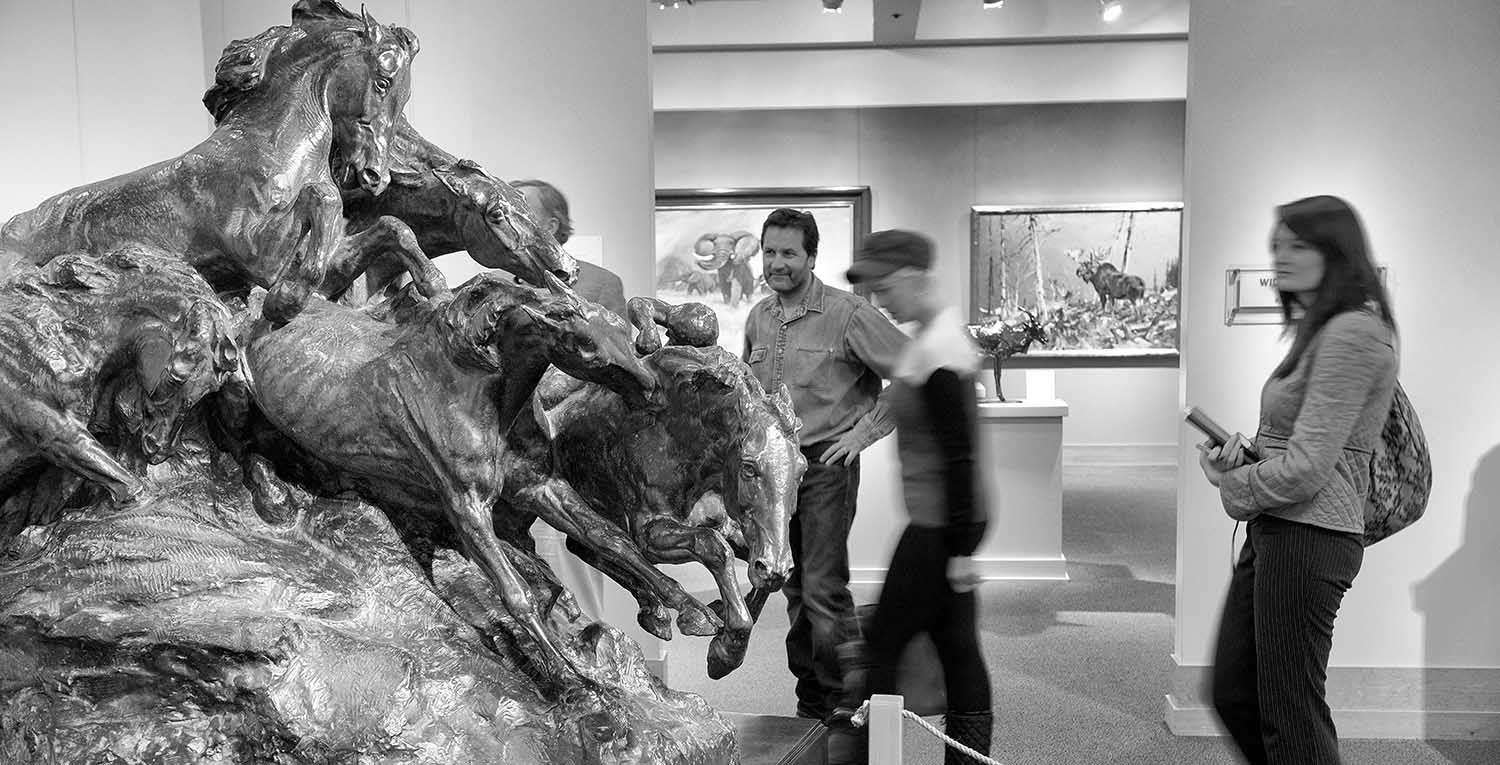
Our nation’s National Museum of Wildlife Art.
Outsized Arts & Culture
The same passion that inspires conservationists to protect Jackson Hole’s wild lands, wildlife and outdoor recreational opportunities also fuels the valley’s arts and culture scene. The National Museum of Wildlife Art, Grand Teton Music Festival, Center for the Arts, Dancer’s Workshop and Jackson Hole Wildlife Film Festival are just a few of the cultural organizations and events that draw some of the best and brightest talents here to perform and share their gift s. The New York City Ballet and cellist Yo-Yo Ma perform here on a regular basis.
“Jackson Hole now attracts artists like Chinese sculptor Ai Weiwei and has more art galleries per capita than almost any other community.”
The wild beauty and unique energy of Jackson Hole’s vast open spaces inspire extraordinary artworks in many forms, from traditional landscape paintings to larger-than-life sculptures, to contemporary multi-media art. Thanks to the benevolence of art patrons, Jackson Hole now attracts artists like Chinese sculptor Ai Weiwei and has more art galleries per capita than almost any other community. The Art Association of Jackson Hole sponsors incredible summer camps, art fairs and adult education, while also supporting a vibrant gallery scene.
“I have a theory as to why Jackson is so creative,” says Kathryn Turner, a nationally acclaimed plein-air painter who has had the privilege of growing up here. “This place is beautiful—that’s a no-brainer—but I think another factor is in play, and it’s how dynamic the natural world is here. … Each day here is special, so you’ve got to capture it. Take a picture of it, paint it; it’s fleeting.”
The culture is so strong that one nonprofit, The Center of Wonder, started a calendar to keep track of all our local cultural events: dailywonder.org/cal
BIG THINKERS: Every year, big thinkers come to Jackson Hole to talk about the state of the economy, wildlife and wildlands management. A few examples:
- The Federal Reserve Bank’s Economic Policy Symposium, which began meeting in Jackson Hole in 1981, is one of the longest-standing central banking conferences in the world.
- The SHIFT Festival (Shaping How we Invest For Tomorrow) hosts emerging leaders in adventure and conservation to discuss solutions to climate change and opportunities to preserve, protect and promote public lands.
- Every other year on even years, the world’s leading wildlife filmmakers come to Jackson Lake Lodge in Grand Teton National Park for what is widely considered the Oscars of wildlife film: the Jackson Hole Wildlife Film Festival & Conservation Summit, hosted by Jackson Hole Wild.
- In the first week of October, TEDxJacksonHole hosts a speaker series.
The Code of the West
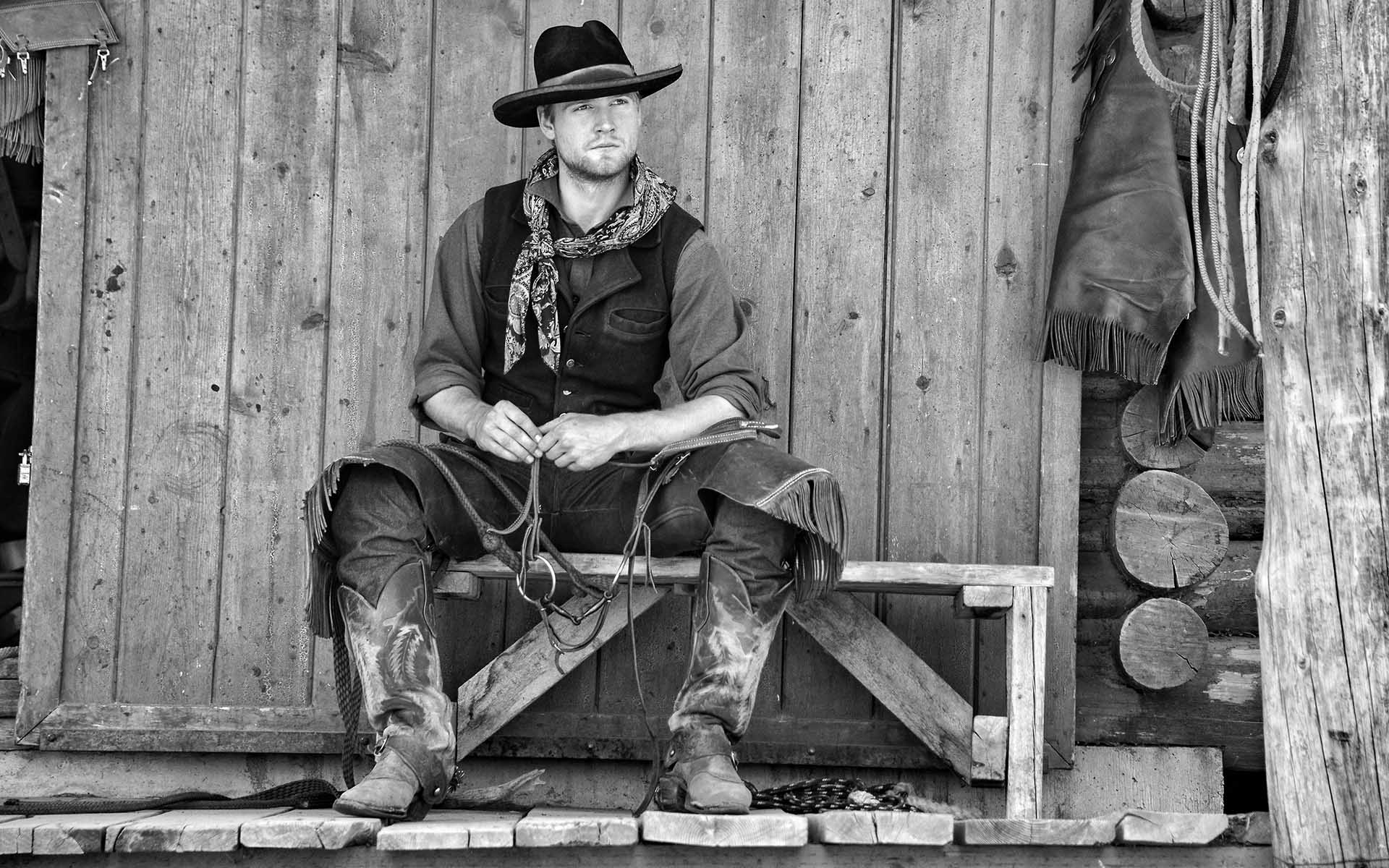
Cowboy William Dunn, multi-generational Wyomingite, at the Triangle X Ranch, in Jackson Hole
An Act declaring “The Code of the West ” as the official state code of Wyoming was signed into law on March 3rd, 2010, with these 10 guidelines taken from the book Cowboy Ethics, by James P. Owen:
- Live each day with courage.
- Take pride in your work.
- Always finish what you start.
- Do what has to be done.
- Be tough, but fair.
- When you make a promise, keep it.
- Ride for the brand.
- Talk less and say more.
- Remember that some things aren’t for sale.
- Know where to draw the line.
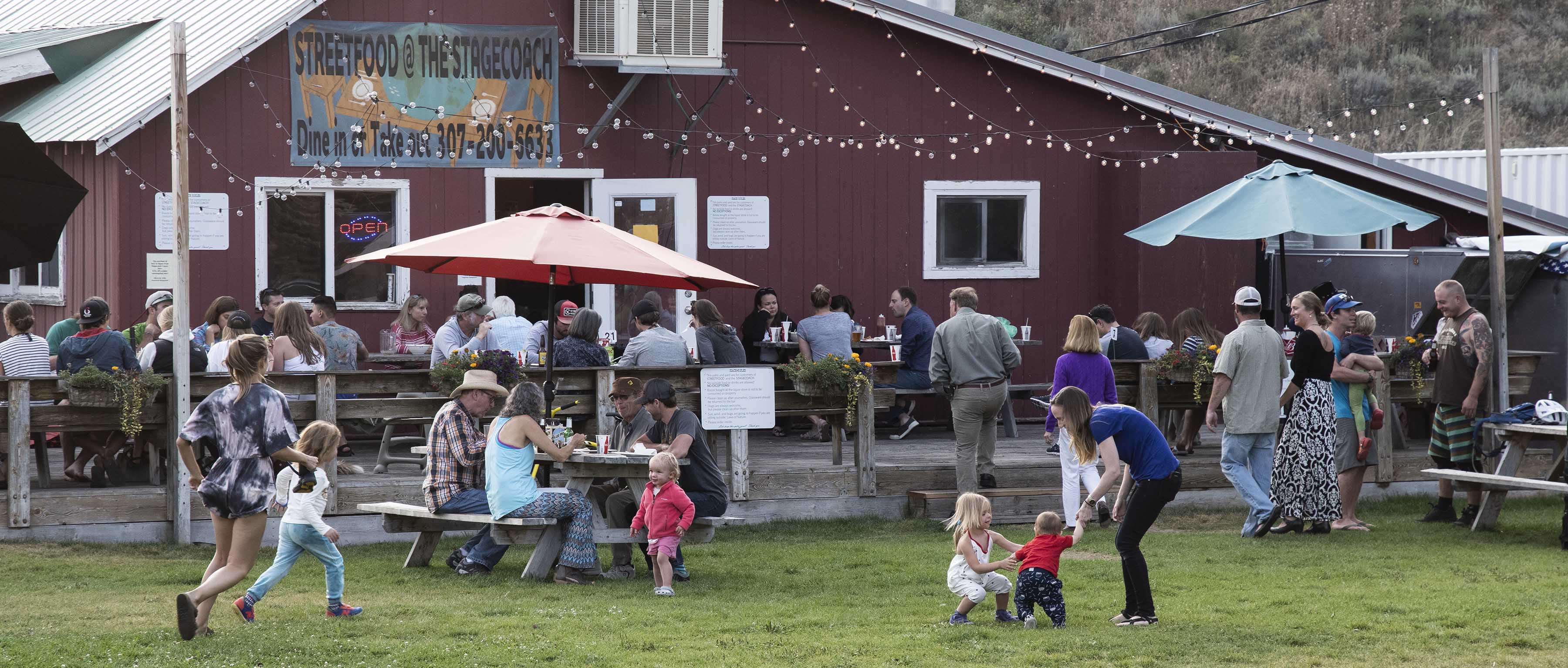
Outsized Quality of Life
When I think about why most of my friends moved to Jackson Hole, it really comes down to quality of life. Conversations are rarely centered on what you do for a living. People are more interested in what you are passionate about and the adventures you’ve been on lately.
If you have children, Jackson Hole provides an instant community of parents and kids who are excited to share adventures with you and your family. I especially enjoy the quality of family time I get here. Whether it’s hiking in a national park or boating at a lake, most social events include kids. Our friends are our extended family.
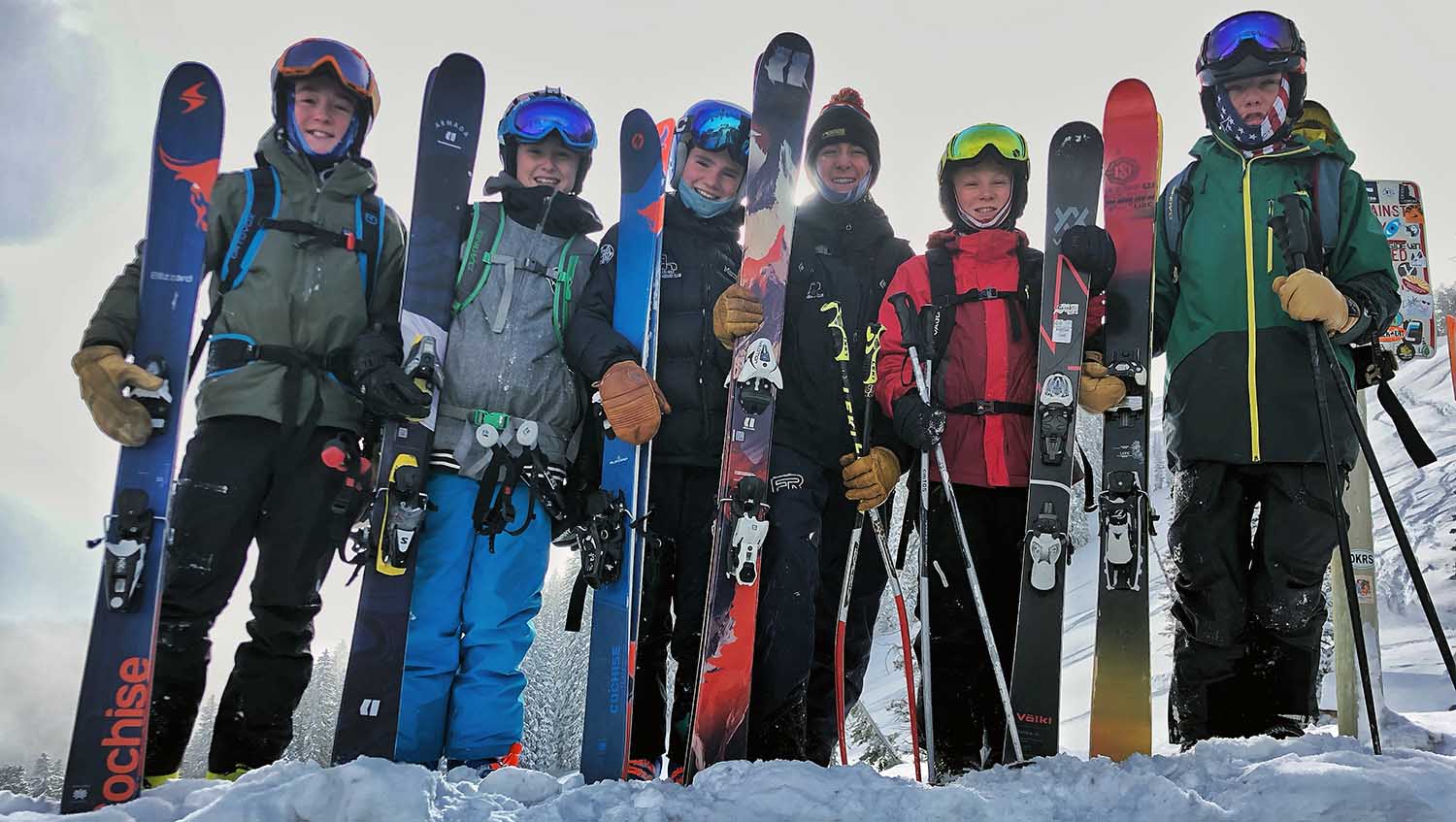
Kids skiing Teton Pass on a teacher workday.
As children grow up, they can enjoy more freedom here than in most places because of the small community size, readily available public transportation and parents looking out for each other’s kids. Some may even go so far as to say that the ethics of the “cowboy community” and the Code of the West have helped promote a self-policing system that makes our community safe.
People who live here have a shared set of values and love of Jackson Hole that allow us to break down barriers and form deep and meaningful bonds. There’s no better place to see this in action than going to “Church” at the Stagecoach on a Sunday night, where cowboys, billionaires and ski bums have been rubbing elbows and two-stepping together for more than 50 years. Unlike most mountain towns, there is a reverence for the Old West and a living history of the cowboy lifestyle.
The history of adventure in the Tetons goes back to before the Stagecoach Band’s Bill Briggs first skied down from the summit of the Grand Teton in 1971. Today, you can combine that kind of adventure and solitude in nature with some of the finest art, culture and dining experiences right outside your back door. It is possible to climb the Middle Teton, float or fish the Snake River, or ski the backcountry and be home in time to get ready for a 7 p.m. reservation at the Snake River Grill.
The focus on balancing work and play in Jackson Hole promotes a healthy lifestyle. In 2018, U.S. News and World Report ranked Teton County the sixth-healthiest community in the nation.
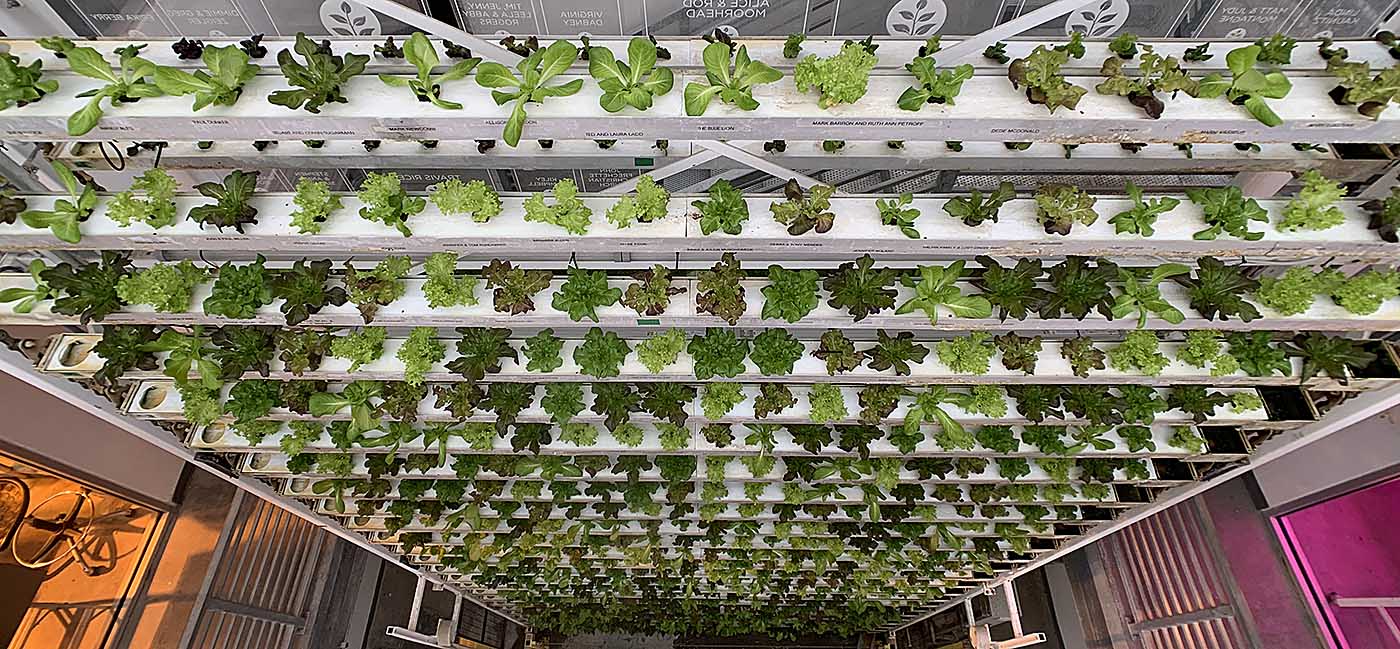
Three-story hydroponic farm, Vertical Harvest in downtown Jackson, Wyoming.
Similarly, a recent study conducted by Reservations.com that mapped 50 “blue zones” in the U.S.—identifying the county in each state that best promotes longevity through healthy lifestyles—ranked Teton County sixth in terms of lifestyle and second for life expectancy (87.4 years). The study was based on criteria originally established by author Dan Buettner, who pinpointed communities around the world with the longest-living people. Among the factors considered were a habit of frequently moving within your natural environment, a feeling of belonging in the community, a dedication to putting loved ones first, and a “why I wake up in the morning” sense of purpose—all qualities that run strong in Jackson Hole.
In addition to engendering a greater appreciation for nature, the time we spend outdoors motivates us to stay in shape and eat well—so we can keep up with our adventure partners! Two different farmers markets and three major grocery stores cater to our desire for good nutrition. A cutting-edge greenhouse, Vertical Harvest, acclaimed for its innovative use of space and diverse workforce, supplies fresh produce to many of the local grocers and restaurants.
This community’s commitment to health is also reflected in the five-star rating our local hospital, St. John’s Health, recently received from the Centers for Medicare and Medicaid Services, a designation awarded to only a handful of hospitals nationwide.
Unlike other communities where parents struggle to get their kids outside, our kids here can ski all winter and participate in countless outdoor activities in the summer. The biggest challenge is keeping them outfitted in all the gear they need, from skis to hiking boots, kayaks to mountain bikes. Thank goodness for the annual community ski, bike and boat swaps!
For families who lack the resources to buy recreational gear, local philanthropy has once again stepped up to the plate. The Doug Coombs Foundation is a perfect example. Each year, it sponsors 180 low-income children in a winter-long ski program, providing everything from lift tickets and instruction to skis, boots, helmets, goggles and jackets.
“Sunday Church” at the Stagecoach
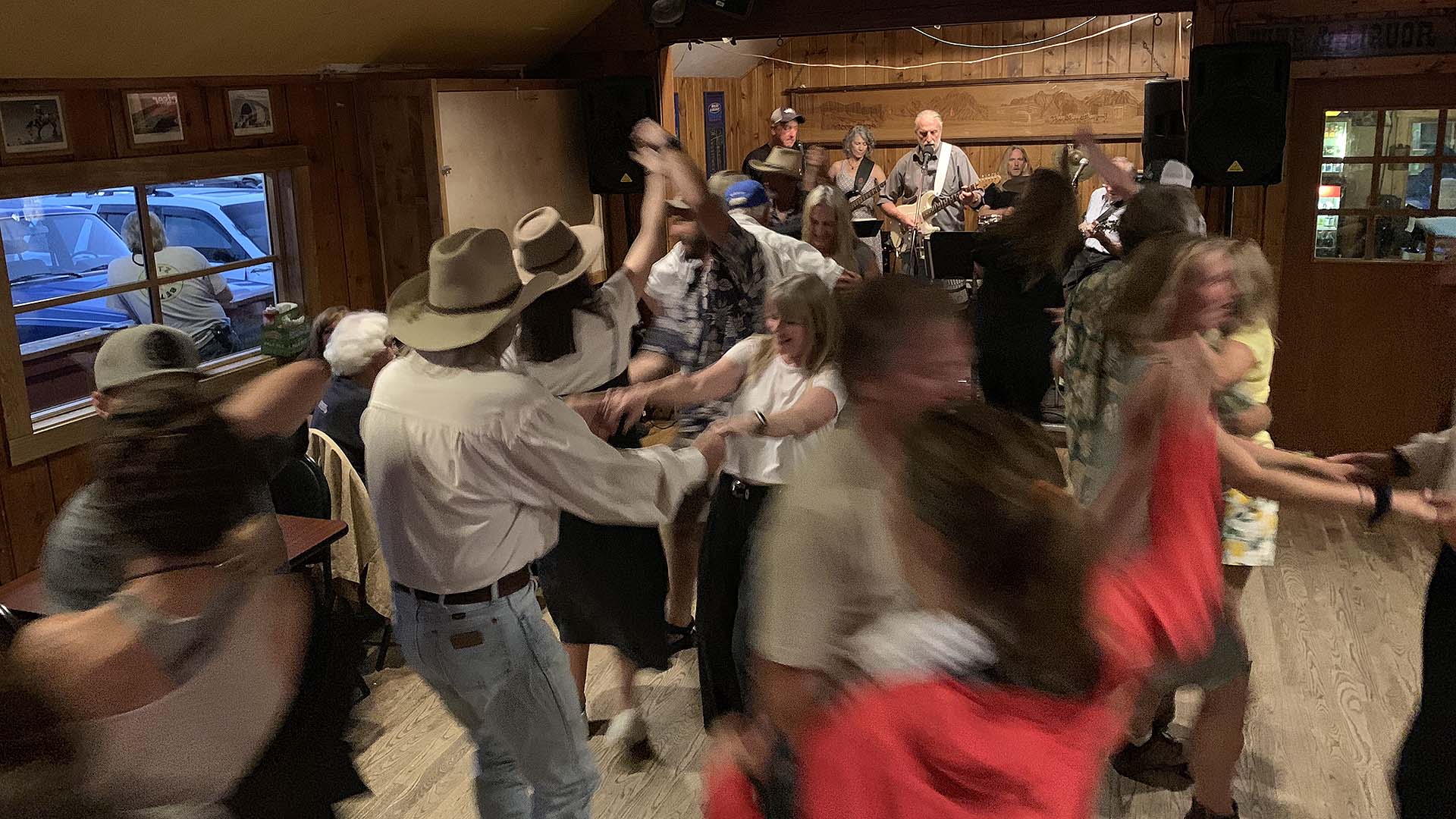
“Sunday Church” at the Stagecoach Bar
In 1942, 10 years after prohibition, when Franklin Roosevelt was president and John Wayne had just filmed “Wyoming Outlaw,” the Stagecoach bar, at the base of Teton Pass, became the watering hole of Wilson, Wyoming. Since 1969, The Stagecoach Band has had a regular gig on Sunday nights from 6 p.m. to 10 p.m. Locals call it “Sunday Church” because it is so revered. The band always ends the set with a campfire rendition of “Keep on the Sunny Side of Life.” It’s a perfect way to bookend your weekend and set you off on the right foot for the coming week.
People of all walks of life share the storied dance floor in what has been described as a great melting pot. The songs enliven swing dancing and two-stepping, and the music is orchestrated by the infamous Bill Briggs, the first person to ski the Grand Teton. Briggs, who was born in 1931, is older than the bar itself, yet he has rarely missed an opportunity to play banjo, autoharp and 12-string guitars with his band. If you are lucky, you will get to hear him yodel.
The bar has been featured in James Blunt’s video “Bonfire Heart” and has been the subject of a feature film by local filmmaker Jennifer Tennican, who also made a film about the Vertical Harvest greenhouse. “Whether you are a ranch hand, tourist or movie star, it’s just a great, great place,” said Cle Clark, owner of the Stagecoach from 1962 to ’73, in a 1984 Jackson Hole News quote on the Stagecoach website.
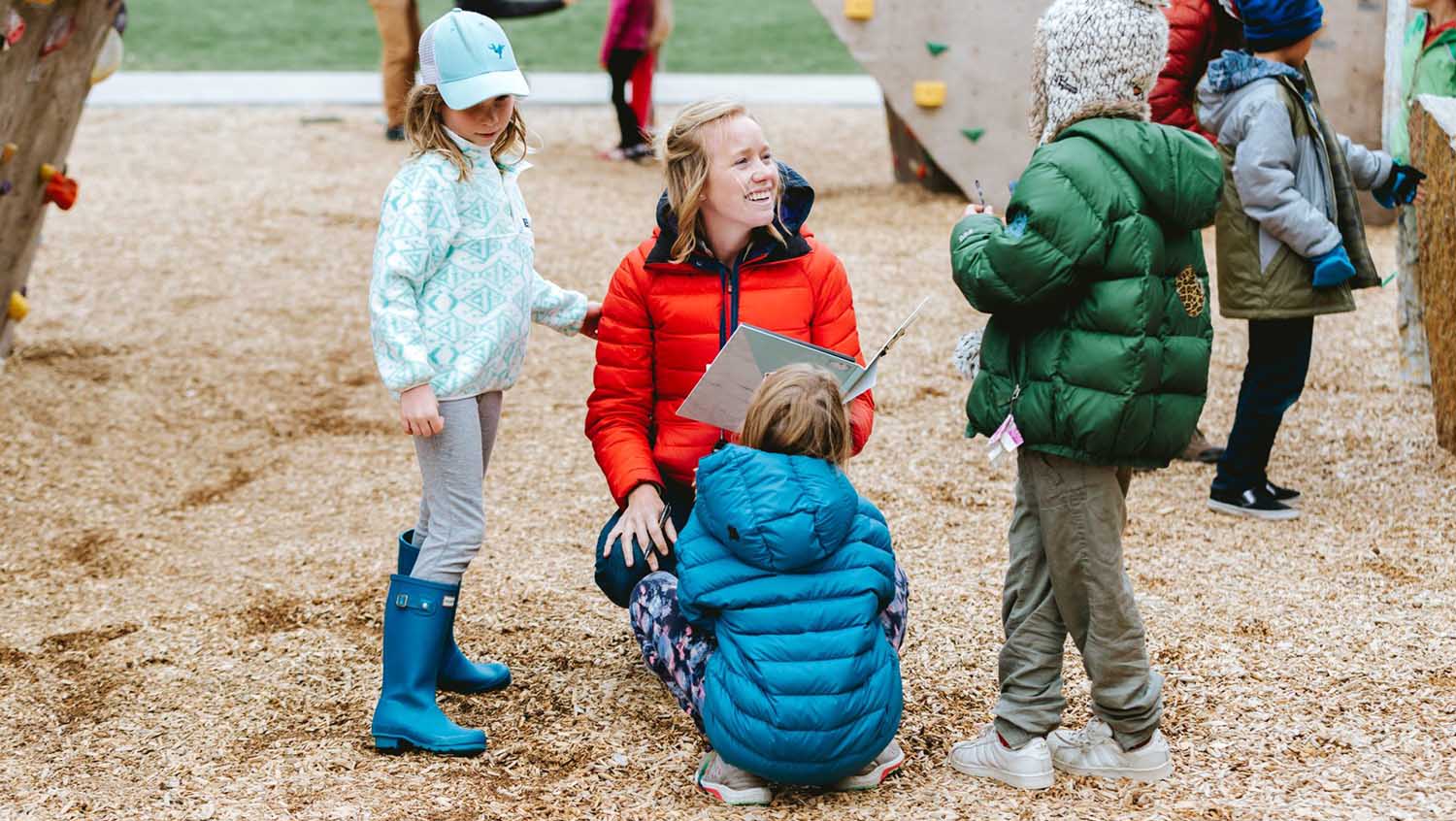
Mountain Academy’s mission is to inspire curiosity, engagement and leadership through transformative, place-based education.
Outsized Educational Opportunities
For such a small community, Jackson Hole has not only big culture but also a lot of choices when it comes to education. In addition to a reputable public school system,
Teton Science Schools runs a grades K-12 place-based Mountain Academy, which offers International Baccalaureate classes at the high school level, field studies, graduate school courses and a new independent study program. Other private school options include The Classical Academy (K-8) and Jackson Hole Community School, a college-preparatory high school.
The average salary for a local elementary school teacher is $55,649 per year, which is 21 percent above the national average.
As an energy-rich state with no income tax, Wyoming spends more per student than any other state in the nation other than Alaska.
The school district ranked sixth in the nation in a 2019 Education Week Research Center study. According to the National Assessment of Educational Progress 2018 report card, Wyoming students tied with students from six other states for the top rank in fourth-grade mathematics scores. They continue to remain above the national average in fourth- and eighth-grade reading and in eighth-grade math.
Ongoing education and community enrichment classes are abundant at the JH Center for the Arts, where there is a Central Wyoming Community College campus, art and dance studios and a 500-person theater for various performances, films and speaker series, including TEDxJacksonHole.
Public:
Munger Mountain Elementary School
Post-Secondary:
Central Wyoming Community College
Private:
Mountain Academy of Teton Science Schools

Jackson Hole Airport
Outsized Air Access
Even though Jackson Hole is probably one of the only places in the world where pilots circle because there is a moose on the runway, it is possible to live here and stay connected to Ethe outside world. You’ll see the same folks showing up for Monday flights to the major markets like NYC, DC, Chicago and San Francisco, as they have successfully anchored their families in Jackson Hole and still keep their business endeavors in full motion.
Named by Fodor’s Travel magazine as the best “tiny airport” in the World
The airport now supports non-stop flights from 13 major cities, and aircraft as large as the Boeing 757-200 as well as a fixed-base operator (private terminal) adjacent to the public terminal. The increased frequency of flights and quality of connections have been a game changer for Jackson Hole’s local economy, enabling younger families and empty nesters to relocate here. I have friends who say, “I used to spend the week on the road and return to a locale that was not inspiring. Now I come home to wonderment.”
Jackson Hole is the only commercial airport in the U.S. that is located in a national park; it is also a popular mating ground for the rare sage grouse. The airport was established in the 1930s with a terminal resembling a pioneer log cabin. In 2014 it was redesigned by the renowned architectural firm Gensler. The new design, which blends with the unique surroundings, received an award from the American Institude of Architects.
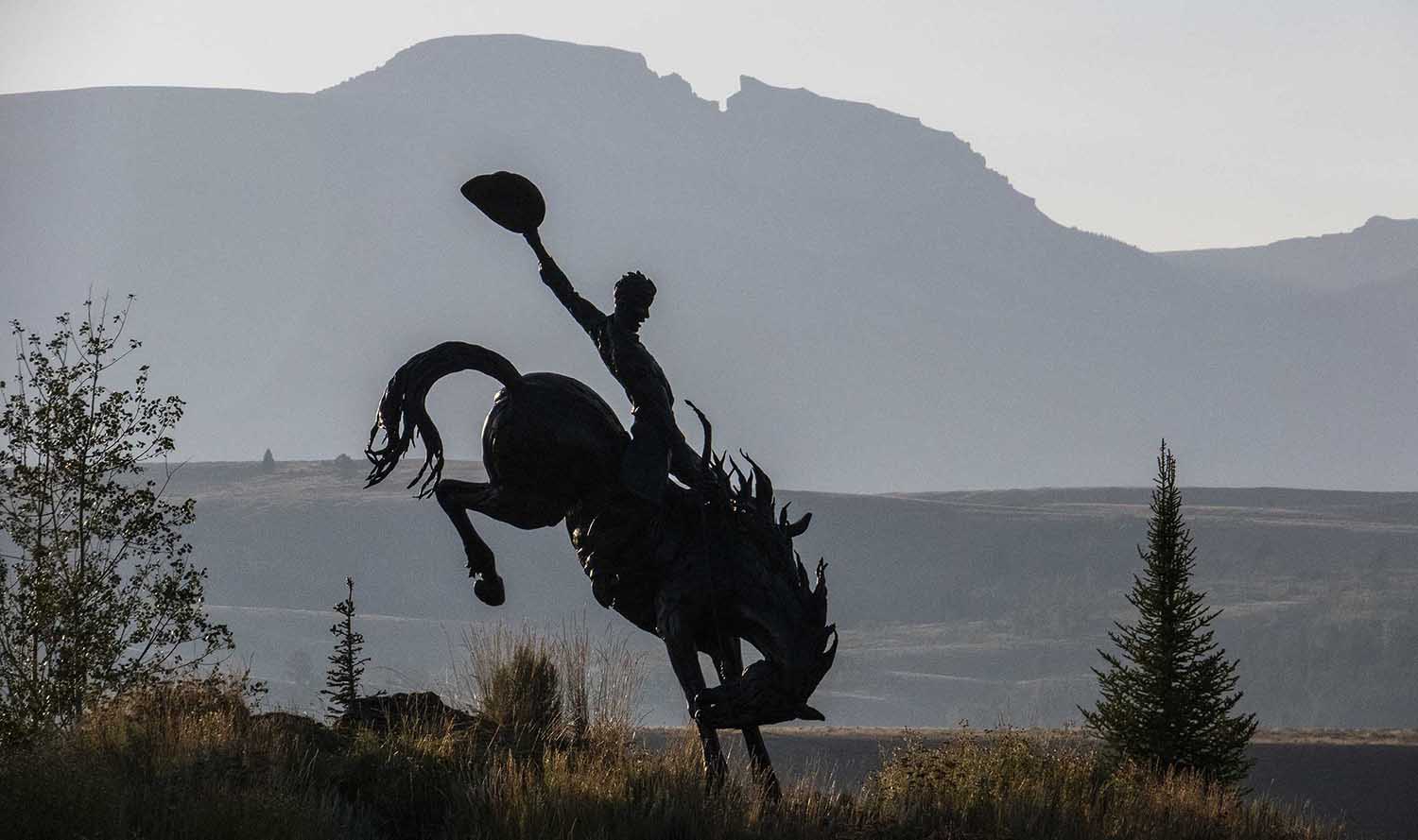
The symbol for Wyoming, “Bucking Horse and Rider,” with the Sleeping Indian in the backdrop.
Outsized Tax Benefits
In 2019, Kiplinger rated Wyoming the #1 Most Tax Friendly State, and Bloomberg Wealth Manager called Wyoming the most wealth-friendly state. Why? It has some of the lowest property and sales taxes in America and no income taxes, estate taxes, no taxes on gas and groceries, no taxes on financial assets (including stocks and bonds), no taxes on the sale or gift of real estate and no taxes on out-of-state retirement income, which makes it extremely friendly for those who want to pass down their wealth. In addition to all of the tax benefits above, dynasty trusts shield real estate from federal estate taxes for up to 1,000 years.
Wyoming is the #1 Most Tax-Friendly State in the US.
– Kiplinger, 2019
In addition to being named the nation’s Most Business Friendly Tax Climate five years running through 2017 by the Tax Foundation, Wyoming provides a variety of advantages for businesses looking to relocate or expand, including no corporate income tax.
Tourism provides half our sales tax and helps fund more outsized amenities, like public transportation, pathways and cultural programming. For me, with everything this amazing valley has to offer, the tax benefits are just icing on the cake.
As one of the best on-shore tax havens in America, Wyoming’s tax structure encourages philanthropy. With a lot more money in their pockets, Jackson Hole residents reinvest generously in the community’s thriving nonprofit organizations. Thus the outsized economic rewards of living in this unique valley help to inspire the conservation, philanthropy and creativity that make it so special in the first place.
How to Take Advantage of Wyoming’s Tax Benefits
To learn more about Wyoming’s tax benefits and how to achieve residency in the state, go to: http://www.livewaterjacksonhole.com/the-jackson-hole-way/wyoming-tax-benefits/
###
[Order a free printed copy of “The Outsized Reasons Why You Will Fall in Love with Jackson Hole.” ]
By Latham Jenkins, edited by Lix Prax . Photography by Latham Jenkins unless noted otherwise.
